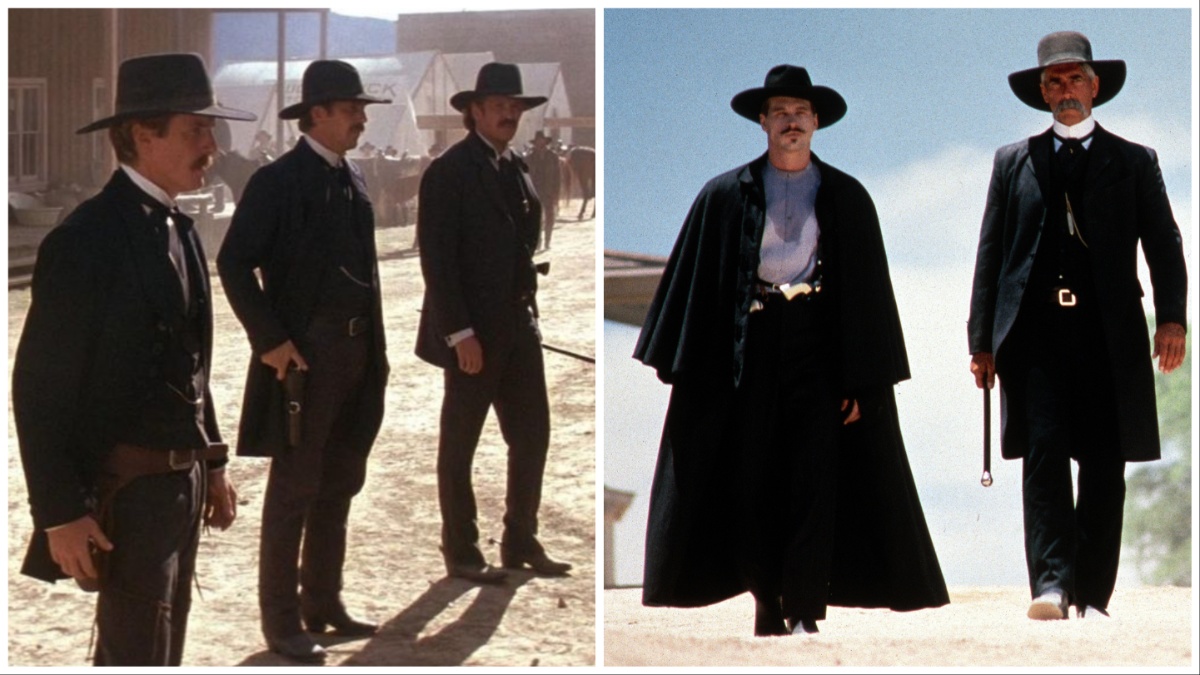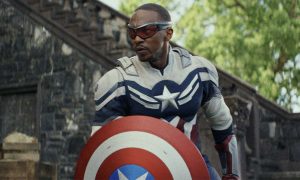
Twin movies. Doppelgängers. Rapid fire remakes. Whatever you want to call them, Hollywood studios have a long and painful history of rushing concepts that run the gamut from similar to identical into theaters at virtually the same moment. Oftentimes the belief is if you get before the cameras first, the competitor(s) will throw in the towel and cancel production. Yet once in a while what seems like a turf war played out in industry trade papers, where the disputed territories are overlapping ideas or historical personages, spills out into the multiplex as “the same movie” comes to cinemas weeks or months apart.
This phenomenon is more than a hundred years old, with the first such instance believed to be two silent adaptations of Ivanhoe being produced on different continents in 1913, although a clearer kickoff might be when Paramount and MGM competed to get the first American Mata Hari movie into cinemas during the glory days of Hollywood pre-Code sin in 1931. Ever since, be it Bette Davis essentially making her own Gone with the Wind before Gone with the Wind, or the fact we got three werewolf movies in the same calendar year of 1981, Hollywood has had a tendency to clone itself.
Even so, the decade that might have been the most guilty of this phenomenon was the 1990s. It was after all a peak time for “high-concept” entertainment, which partnered movie stars with premises that could fit inside a poster’s tagline. And believe it or not, it wasn’t always who got there first who won the race…
Tombstone vs. Wyatt Earp
The best place to begin is probably with the O.K. Corral duel that just turned 30. Twice. Released a mere six months apart, with Tombstone coming out in December 1993 and Wyatt Earp galloping right behind in June of ’94, these two share a lot in common by virtue of being a pair of serious(ish) attempts at sticking to the historical record of Wyatt Earp, Doc Holiday, and the outrageous events in the Arizona territory circa 1882. In fact, at one point they even shared a lead actor since Kevin Costner was circling Tombstone and its writer-director Kevin Jarre before dropping out at the 11th hour to play the same part in his buddy Lawrence Kasadan’s rival production.
The way it went down caused Jarre to claim to the press that Costner was trying to “crush my picture,” which might not have been far from the truth. But because of a bullish pre-production rush—a speed so fast that it also led Jarre being fired from the picture—Tombstone was able to beat Wyatt Earp to theaters.
Who won? Sometimes it really does pay to be first. And better. Despite Tombstone being hidden from critics, the film turned out to be a word-of-mouth hit including with reviewers like Roger Ebert who was so bowled over by Val Kilmer’s performance as Holiday that he sniffed six months later: “Wyatt Earp plays as if they took Tombstone and pumped it full of hot air.” Audiences agreed since Tombstone earned $57 million, more than double what Wyatt Earp took home ($25 million).
Deep Impact vs. Armageddon
Another of the most famous ‘90s showdowns is one where the qualities and rewards were more ambiguous. The only thing certain is that back in the summer of ’98, you needed to have an opinion about what was the better movie, Deep Impact or Armageddon? With the former being released in May and the latter in July, not even two full months passed between the pictures. And the way folks on Deep Impact tell it, that was bitterly by design.
Originally pitched as a hard science fiction drama about what would happen if a comet threatened an extinction level event on Earth, Deep Impact was once pegged to be a Steven Spielberg directing vehicle. But after Armageddon was announced while Spielberg was still working on Amistad, Deep Impact was rushed into production with director Mimi Leder to get to cinemas first. According to Deep Impact writer Bruce Joel Rubin, Disney executives even sat in on a luncheon where they heard a pitch on the movie and subsequently began hiring a squadron’s worth of writers to break Armageddon for Touchstone Pictures. Hmmm.
Who won? It turns out you can be first and still last. While astronomers and academics noted the more dramatic and character-driven Deep Impact was also more scientifically convincing (they actually had experts on set), Michael Bay’s macho-blue-collar-oil-drillers showing those eggheads at NASA how to get **** done (ask Ben Affleck) appealed better to audiences—as did Bay in his first PG-13 experiment in maximum Bayhem being coupled with a pop song (in this case Aerosmith’s inescapable “I Don’t Wanna Miss a Thing”). Deep Impact grossed a respectable $140 million in the U.S. and $350 million globally. Armageddon earned $202 million in the U.S., making it the second biggest movie of the year; worldwide it came in at number one with a total of $554 million.
Dante’s Peak vs. Volcano
Like the 1970s before them, the ’90s saw disaster movies become all the rage. Call it Boomer nostalgia or the chance to redo all those old Irwin Allen scenarios with new CGI technology, but American audiences couldn’t get enough of us being wiped out by asteroids, aliens, tornados, or even volcanoes. Thus the boiling hot spring of 1997 when we got two movies about liquid magma coming up to kill: Dante’s Peak and Volcano.
Starring Pierce Brosnan, fresh off GoldenEye, and Linda Hamilton, Dante’s Peak is the more character-driven and (slightly) more plausible disaster film of the two, with its emphasis on a small town in the American Northwest oblivious to its impending doom (read: Mount Saint Helens). In the film, the characters have more to fear from the atom bomb-like imagery of ash and rock falling from the sky. Conversely, Volcano is a true Irwin Allen-like ensemble piece where Los Angeles residents, including a mismatched Tommy Lee Jones and Anne Heche, must pool together to fight rivers of lava from invading their neighborhoods like it’s a band of aggressive gentrifiers.
Who won? With the critics? The answer would be neither, although Roger Ebert at least begrudged, “It’s said that Volcano cost a lot more than Dante’s Peak… but it doesn’t look it. Dante’s Peak had better special effects, an entertaining story, and a real mountain. Volcano is an absolutely standard assembly-line undertaking.” Audiences once again agreed with Roger since Volcano earned $123 million worldwide, well below Dante’s Peak’s $178 million summit.
Antz vs. A Bug’s Life
As the competition that ended friendships, the Antz and A Bug’s Life rivalry is all the more bizarre when one remembers Antz was considered a threat to Disney because it starred, uh, Woody Allen… the ‘90s were a different time, eh? It was also a period where Pixar was not yet owned by the Mouse House and was green enough for its co-founder John Lasseter to tell a friend at a rival studio, namely Jeffrey Katzenberg, that they were working on a movie called “Bugs” about a worker ant rising in an ant colony’s society and impressing the queen-to-be. That’s at least how Lasseter and fellow early Pixar leader Steve Jobs remembered it to Jobs’ biographer, Walter Isaacson. So imagine their surprise when months later, the trades announced that Katzenberg’s new DreamWorks (which Katz co-founded after leaving Disney while Toy Story was in development), was also developing an animated bug movie called Antz.
Lasseter and Pixar animators claimed betrayal and umbrage, although to this day Katzenberg insists he first heard a pitch for Antz back in the early ‘90s when he was still at Disney. Whatever the case, Antz’s allegedly more adult sensibility (it again starred the voice of Woody Allen, as well as Sharon Stone, Sylvester Stallone, and Christopher Walken) reached theaters first by little more than a month ahead of the retitled A Bug’s Life.
Who won? Antz might have gotten there first, but for all its novelty and sexual innuendos between computer-generated ants, the more classic adventure story of A Bug’s Life (and its Disney/Pixar magic) won out. The New York Times’ Janet Maslin wrote, “Antz started with the same collective mentality and then invoked bugs with star personalities… to deliver some zest. But [in Pixar] the ants’ story is more coherent on its own terms, so the audience is more caught up in narrative than in all-star individual characters.” Antz tapped out at $172 million worldwide and $91 million domestic; A Bug’s Life collected $363 million worldwide and $163 million locally.
Robin Hood: Prince of Thieves vs. Robin Hood
There must really have just been something about Kevin Costner back in the ‘90s, because he seemed to always be the top choice for any role—even when that role was of a 12th-century Anglo-Saxon nobleman. This fact of life is also the reason why Robin Hood: Prince of Thieves was able to crush John McTiernan’s dream of doing a Robin Hood movie. Fresh off Predator and Die Hard, and with The Hunt for Red October in the pipeline, McTiernan coveted making a Robin Hood movie at 20th Century Fox. He even had discussions with Costner to star before Costner scooted over to Warner Bros. for a slightly edgier take courtesy of his pal Kevin Reynolds nabbing the director’s chair (this sound familiar…).
Unlike the Wyatt Earp fiascos, there was no happy ending for Fox’s production. While they also approached Mel Gibson about slipping into some green tights, ultimately it became clear WB’s Prince of Thieves was going to get to the big screen first. Fox’s chairman at the time, Joe Roth, even lamented in the press that WB’s production partner Morgan Creek acted “unjustly, if not immorally.” A quickie economy-scaled version of McTiernan’s treatment was made as a “British” production. It was directed by John Irvin and starred Patrick Begin and Uma Thurman. It even beat Prince of Thieves to American audiences by a month… on network TV.
Who won? It’s not really fair to compare, is it? While the Bergin-starring Robin Hood did have a theatrical release in Europe, including in the UK where it was filmed, the movie was a tiny-budgeted (and frankly terribly scripted) shadow of whatever it was originally meant to be. Love or hate it, Prince of the Thieves meanwhile had Alan Rickman as the Sheriff of Nottingham and grossed $391 million, making it the second biggest movie of 1991, behind only Terminator.
Con Air vs. Air Force One
The overlap between Nicolas Cage’s second round at trying to be an action star and Harrison Ford’s umpteenth looks a lot more coincidental than other “twin movies” on this list, but back in the summer of ’97 it seemed pretty odd to have two movies about bad guys taking over a plane and needing to be grounded. With each movie riffing on the Die Hard setup, perhaps the biggest difference is what kind of plane they’re set on, and the energy of the guy doing the Die Hard-ing. In the case of Con Air, it is a prison transport that’s been hijacked by the convicts who in maximum wannabe-Bayhem decide to take the party to Vegas (its star did just earn his action bonafides the previous year in Michael Bay’s The Rock).
Also if you ask Nicolas Cage to do a Southern accent in a tank top, you might as well let John Malkovich or Steve Buscemi go ham too. Meanwhile Harrison Ford essentially got to make his third Jack Ryan movie while cutting out rights holder Tom Clancy. If you aren’t paying attention, you could easily mistake Ford’s President Jim Marshall for Jack. He also has a wife and daughter he must protect when Gary Oldman somberly makes the mistake of getting on his plane.
Who won? Both did very well in their lanes, with Con Air grossing $101 million million in the U.S. and $224 million overall versus Air Force One’s $173 million domestic and $315 million worldwide. But the one released a month later and starring Ford did come out on top at the box office and with critics, who generally saluted President Ford for his service while rolling their eyes at Cage. But if we’re being honest, almost 30 years later Con Air is a helluva lot more fun.
Independence Day vs. Mars Attacks!
While one is ostensibly a comedy and the other is “dramatic,” no one at Warners was laughing when they saw a flying saucer hovering above the White House in Fox’s Super Bowl spot for Independence Day. According to Mars Attacks! screenwriter Jonathan Gems, WB even had reason to regret their demands to remove scenes of planned destruction in New York City from the script (the very iconography that Roland Emmerich rode to box office glory with ID4).
Both films draw from 1950s alien invasion films and sci-fi cheese. The difference might be Tim Burton‘s Mars Attacks! plays itself as aware of those tropes and influences, and asks audiences to smile at them. Independence Day couches them in modern CGI and narrative beats taken from a thousand other more recent hits like Star Wars, The Right Stuff, and Jurassic Park (it even casts Jeff Goldblum as a heroic know-it-all).
Who won? Independence Day opened in the summer, and Mars Attacks! was essentially dead by winter (its time of release). In its day, Mars Attacks! was repeatedly compared to, and beneath, ID4. The LA Times’ Kenneth Turan commented, “Mars Attacks! is all 1990s cynicism and disbelief, mocking the conventions that Independence Day takes seriously.” ID4 became the biggest movie of the year, domestic and abroad, earning $817 million in ‘90s money. Mars Attacks! flopped, crawling its way to not quite $38 million domestic and barely $100 million overall.
The Truman Show vs. EDtv
As two movies that both inadvertently predicted the rise of reality TV—and by extension the performative and voyeuristic nature of social media—we’re frankly more impressed by the prescience of both The Truman Show and EDtv than we are taken by the fact that they happened to share the same rough setup while opening months apart.
The Truman Show is the more operatic and glossy of the two movies, enjoying that specific ‘90s sheen when an auteur like Peter Weir was making a “message movie,” in this case about the growing rot of our entertainment industry and media consumption habits. It also starred Jim Carrey at the height of his popularity as the poor schmuck who doesn’t know his life is a 24/7 reality show (or livestream?) and Ed Harris as his Dr. Frankenstein-like creator. EDtv is much smaller stakes and rom-com-y about an everyman (Matthew McConaughey) who is manipulated into signing his life away and becoming basically the first reality TV star stuck with cameras and fame-seekers following him around.
Who won? The Truman Show in a blowout. As the perfect type of “important” Hollywood project, it not only grossed $264 million worldwide but was nominated for three Oscars, including for Weir and Harris (but infamously not Carrey). EDtv was left to die that spring by Universal, and die it did with a worldwide total of only $35 million. Roger Ebert mused, “Although the two films have different approaches (Truman is a parable, EDtv is an ambitious sitcom), they’re both convinced that enormous audiences would watch intently as a man brushes his teeth, clips his nails and is deceived by a wicked woman. Is this true? Would they?” Oh, Roger…
The Haunting vs. House on Haunted Hill
In what could in retrospect be considered a preview of the trends to come in 2000s horror, the ‘90s ended with two very different kinds of haunted house classics getting the schlocky remake treatment. First up was The Haunting, Jan de Bont’s ill-advised remake of the 1963 Robert Wise triumph of the same name, both of which are based on Shirley Jackson’s The Haunting of Hill House. Look, de Bont was the cinematographer wunderkind who helped make Hunt for Red October and Die Hard look amazing, and as director he remade the latter to riveting effect in Speed and just had a hit with the early CGI spectacle, Twister. So it seems on paper like a good idea to wow ‘em again with CGI in the horror genre—plus a cast led by Liam Neeson and starring up-and-comers like Catherine Zeta-Jones and Owen Wilson.
House on Haunted Hill, conversely, had less beloved origins since the original 1959 movie was a glorified amusement park attraction from famed showman William Castle and noted ham Vincent Price. So producer Joel Silver churning out a quickie, R-rated programmer for WB in time for Halloween makes sense. He also assembled a cast of rising talents like Famke Janssen, Taye Diggs, and Ali Larter, but the best choice was getting Geoffrey Rush to do a pretty spot on bit of Price-ian scenery-chewing.
Who won? Neither got a single valentine’s from critics (which sounds about right). The Haunting also gobbled up $177 million versus House on Haunted Hill’s $43 million. But we’ll point out House more than doubled its $19 million budget while The Haunting’s $100 million budget does not include a much heftier marketing push needed to convince wider PG-13 demos that the movie was good. (It’s not.)
Saving Private Ryan vs. The Thin Red Line
In 1998 there was a lot of chatter, at least within the industry, about the dueling World War II epics in the works from revered directors like Steven Spielberg and Terrence Malick. Perhaps in retrospect it should not have been viewed as a rivalry given Spielberg’s naturally more commercial instincts and Academy-aligned tastes in art. Conversely, Malick was the guy who only made two features previously, both in the 1970s.
Nonetheless, Saving Private Ryan’s July release date and The Thin Red Line’s December one had the press pit them against each other, particularly in the awards race. Unsurprisingly, Spielberg’s movie was arguably the more conventional view of World War II and lined up perfectly with what Tom Brokaw titled “the Greatest Generation.” While Ryan has the kernel of an incendiary idea, with eight men during the D-Day invasion of Normandy being asked to lay down their lives in order to find a private, the film is ultimately a straightforward love letter to the fathers of the movie’s target audience. The Thin Red Line, meanwhile, is a more esoteric and lyrical character study set in the Pacific during the Guadalcanal campaign. In Malick’s predictably more poetic fashion, it forces audiences to consider what it’s like to be asked to be “the thin red line of heroes,” (a term coined by Rudyard Kipling).
Who won? The one with that electric D-Day landing sequence and stirring John Williams score. Saving Private Ryan was the highest grossing film in the U.S. in 1998 with $217 million (it was second worldwide with $482 million). The Thin Red Line conversely grossed just $36 million in the U.S. and $98 million worldwide. But with passion projects like this, the Oscars were arguably just as important an arena, and both were nominated for Best Picture, Best Director, and a host of other awards. But Saving Private Ryan won Director, even as both lost Best Picture to Shakespeare in Love (much to the world’s shock). To this day though, some argue The Thin Red Line was the better of the the two. Gene Siskel called it “the finest contemporary war film I’ve seen, supplanting Steven Spielberg’s Saving Private Ryan from earlier this year or even Oliver Stone’s Platoon from 1986.” Martin Scorsese also called the Malick film his second favorite movie of the ‘90s.
Rob Roy vs. Braveheart
Another case of two films coincidentally sharing a lot of superficial similarities, Michael Caton-Jones’ Rob Roy and Mel Gibson’s Braveheart are two films about Scottish folk heroes that came out within a month of each other. The first, Rob Roy, starred Liam Neeson as a Scottish clan chief who becomes an outlaw in the 17th century due to his opposition of corrupt Highland lords. The second was Gibson’s directorial debut at the height of his popularity in which he played a highly romanticized version of William Wallace, the Scottish rebel who helped inspire 13th century Scots to overthrow English rule and occupation.
Technically one film is set in the late Middle Ages and the other occurs in the early modern period (Rob Roy uses rifles!), but to the undiscerning American viewer they seemed pretty similar—at least for those who saw Rob Roy…
Who won? Despite being the second to open, Braveheart became the first and loudest battle cry in many viewers’ hearts with the film grossing $213 million at the world box office and winning a slew of Oscars, including Best Picture and Best Director. The only official numbers for Rob Roy’s theatrical run are $32 million in the U.S., less than half what Braveheart took home from that battlefield.
The Last Days of Disco vs. 54
For a brief glorious moment, disco was burning again at the end of the ‘90s. That 20-year nostalgia cycle had blossomed and plenty of filmmakers and executives with fond memories of hanging out at Studio 54 were ready to tell that story in all its gaudy fashion. Such seemingly quaint memories is also what gave us Whit Stillman’s The Last Days of Disco and Mark Chrstopher’s 54 (or more appropriately Miramax’s 54).
Indeed, The Last Days of Disco was a true-blue indie from an elusive and sardonic filmmaker like Whitman, and which starred Chloe Sevigny and Kate Beckinsale before the latter became a star of Hollywood genre fare in the early 2000s. 54, meanwhile, was produced by Harvey Weinstein at the height of his powers and viewed as a possible awards contender with Mike Myers giving a “serious” performance. It also featured rising ’90s talent Ryan Phillippe and Salma Hayek, the latter of whom looked poised to breakthrough. This is why Gramercy Pictures rushed Whitman to complete post-production so they could beat 54 to theaters.
Who won? Truthfully neither at the box office. The Last Days of Disco burned real good with $3 million against an $8 million budget while 54 earned about $17 million against a $13 million budget. However, Whitman’s movie was a hit with many critics that appreciated the acerbic tone and underlying satire of youthful obliviousness. The film to this day has a cult following, although 54 has earned its own after initially receiving scathing critical notices. The film has been embraced as a camp oddity and even reclaimed after writer-director Mark Christopher was able to restore some of his original ideas, including an LGBTQ subtext, which had been removed by Miramax head Harvey Weinstein while he was having the film cut to shreds.
Showgirls vs. Striptease
A battle between “thrillers” fixated on the behind-the-scenes travails of exotic dancing? It doesn’t get much more ‘90s than that. This even includes how both films were received. Though released a sizable nine months apart during 1995 and ‘96, the Demi Moore vehicle Striptease was heavily influenced (at least in its marketing) by the vitriolic backlash against Paul Verhoeven’s Showgirls, a trashy drama so misjudged that star Elizabeth Berkley lost her agent before the film was even out of theaters and couldn’t get another one to take her calls. Thus a more frothy and lighthearted marketing campaign promised Striptease was a comedy the following summer (it’s not).
Honestly, they’re both incredibly dated projects, and their receptions speak to the ‘90s aesthetic of seeking sensation and titillation, and then declaring umbrage after the fact.
Who won? Two years after Showgirls’ release, the movie’s screenwriter Joe Eszterhas lamented to WaPo, “Clearly it was one of the biggest failures of our time. It failed commercially, critically, it failed on videotape, it failed internationally.” Striptease might have been just as reviled by critics, but writer-director Andrew Bergman boasted, “That movie did better than almost anything I’ve been involved with. All the subsidiary stuff was gigantic. People said, ‘I wouldn’t be caught dead seeing it,’ and suddenly when it’s available in a rental store, it’s ‘I’ll get Schindler’s List and Striptease.’” (For the record Striptease also cleared $113 million globally versus Showgirls’ nightmarish $20 million haul.) Still, it’s worth noting that 25 years later, Showgirls has been adopted and reappraised as a supposed camp classic by the LGBTQ community while few remember Striptease exists.
Street Fighter vs. Mortal Kombat
We’re sure that some readers will point out that Street Fighter and Mortal Kombat are wildly different movies and that they never got them confused back in the ‘90s. To which we say, ask your parents what they thought at the time about two schlocky studio programmers released within a year of each other, and that are both based on their kids’ favorite fighting games at the arcade.
On paper December ’94’s Street Fighter and August ’95’s Mortal Kombat looked pretty similar. Star Jean-Claude Van Damme even turned down playing Johnny Cage in the latter to play Col. William F. Guile in the former (he thought Mortal Kombat’s fighting tournament structure was too similar to Bloodsport). He probably lived to regret it since writer-director Steven E. de Souza’s boldly high-concept take on Street Fighter—turning it into a comedic adventure fantasy modeled loosely after UN peace-keeping conflicts of the 1990s—appealed only to Capcom executives who strangely did not want a movie that resembled the setup of its popular video game.
Who won? While Street Fighter is held up as a camp classic in some circles (Raul Julia’s performance will always be gold), Mortal Kombat held the dubious honor of being called the “best video game movie ever” for decades. To pre-teens it was by far the cooler movie, and the box office reflected this with Street Fighter earning only $33 million in the U.S. against Mortal Kombat’s $71 million.
The post Twin Movies of the ‘90s: The Winners and Losers of When They Made the Same Movie Twice appeared first on Den of Geek.







